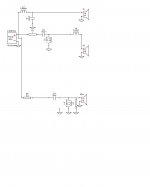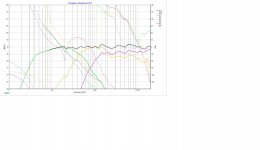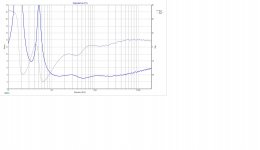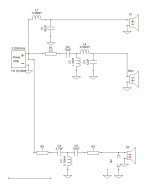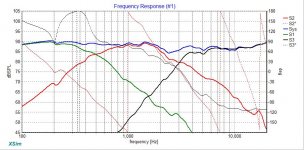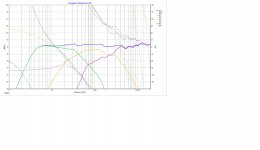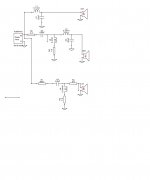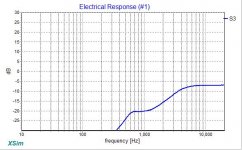I agree, but the OP also tried a lower crossover point around 3KHz, a bit higher than what I'd recommend for a 5" driver but not by much. Let us comment when he can work with more correct input files.
Anyway, this is the normal novice mistake, i.e. looking only at the on-axis FR. Even if one understand the importance of off-axis FR and power response, it is difficult to design without measurement if choosing a driver for which the manufacturer doesn't provide off-axis measurements. I still think that the Tang Band full-range driver is a poor choice here, it may have an extended response but there is no off-axis data, so it is very difficult to know where to cross it to a tweeter. And I'd pick TB data very carefully anyway. IMHO the OP should choose a dedicated mid or a mid-bass, the NE123 or the 830870/830992 just to remain with the same brand as the woofer and tweeter. Those drivers can handle a 3KHz transition to a tweeter very well with a good power response.
Ralf
Anyway, this is the normal novice mistake, i.e. looking only at the on-axis FR. Even if one understand the importance of off-axis FR and power response, it is difficult to design without measurement if choosing a driver for which the manufacturer doesn't provide off-axis measurements. I still think that the Tang Band full-range driver is a poor choice here, it may have an extended response but there is no off-axis data, so it is very difficult to know where to cross it to a tweeter. And I'd pick TB data very carefully anyway. IMHO the OP should choose a dedicated mid or a mid-bass, the NE123 or the 830870/830992 just to remain with the same brand as the woofer and tweeter. Those drivers can handle a 3KHz transition to a tweeter very well with a good power response.
Ralf
I tried Peerless NE123W. The New Crossover is here also. There is a notch at around 2.3 khz. I found it is hard to cross with the tweeter beyond that point. Please have a look and point out the flaws.
Attachments
Driver files are now filled with both magnitude and phase, so in that respect it's better. You have made ne123w.zma as if it were reflex loaded. Usually you don't do that, instead decide on a separate sealed cabinet. Practice working on frd/zma's so they match final enclosure measures, driver positions, internal volume, baffle diffraction conditions. Then you will be set to work on the crossover. There is very little out of band attentuation at midrange LP filter, so increase its order. In XSim when you define the woofer/midrange is behind tweeter, then you positively delay woofer/midrange.
I played a bit with your data, this i just a quick sim:

with this crossover:

As you can see I had to increase the electrical order for both the mid LP and the tweeter HP filters in order to have a decent phase alignment.
I put a 0.75" delay on the mid and a 2" delay on the woofer (0 on the tweeter). Having 0 for the first 2 drivers and a positive value for the tweeter is wrong as the tweeter is (usually) the nearest driver, at least you should have put a negative value on the tweeter.
However before doing further I would try to splice better the cab effect with the FR of both woofer and mid. Now there is a distinct step at 200 Hz that has to go away.
Ralf
with this crossover:
As you can see I had to increase the electrical order for both the mid LP and the tweeter HP filters in order to have a decent phase alignment.
I put a 0.75" delay on the mid and a 2" delay on the woofer (0 on the tweeter). Having 0 for the first 2 drivers and a positive value for the tweeter is wrong as the tweeter is (usually) the nearest driver, at least you should have put a negative value on the tweeter.
However before doing further I would try to splice better the cab effect with the FR of both woofer and mid. Now there is a distinct step at 200 Hz that has to go away.
Ralf
Attachments
Thank you both. I just decided try some other drivers. You can get the names in DXO file. Here is the crossover. Please have a look and tell me your opinions. Off axis power response is one thing i am not able to check. So need some help there also.
Attachments
It seems a flat FR, however obtained at the expense of something, in this case the tweeter, whose contribution at 1KHz and lower is significant. I'm attaching the filter response for the tweeter part, I suspect that the tweeter will be stressed and probably will ring also.

I see you used another full range driver as a mid. Frankly I'd use such a driver for its intended purpose, mating it to a woofer without any tweeter. Examples of this arrangement can be found in this forum. If you want to use the full range as a mid you need to use at least a 3rd order LP electrical filter to achieve something like a LR4 target. An extended response driver like a full range can be used to achieve a LR2 target, however this will work only either with a slanted or stepped baffle, or with a tweeter in an appropriate waveguide, in order to move back the VC of the tweeter.
If you use a "normal" mid driver you can easily achieve LR4 target acoustical slopes with a 2nd order electrical LP filter for the mid, and 3rd order electrical HP filter for the tweeter, as in the example I posted before. Remember that the electrical roll off will add to the natural roll off of the driver.
Ralf
I see you used another full range driver as a mid. Frankly I'd use such a driver for its intended purpose, mating it to a woofer without any tweeter. Examples of this arrangement can be found in this forum. If you want to use the full range as a mid you need to use at least a 3rd order LP electrical filter to achieve something like a LR4 target. An extended response driver like a full range can be used to achieve a LR2 target, however this will work only either with a slanted or stepped baffle, or with a tweeter in an appropriate waveguide, in order to move back the VC of the tweeter.
If you use a "normal" mid driver you can easily achieve LR4 target acoustical slopes with a 2nd order electrical LP filter for the mid, and 3rd order electrical HP filter for the tweeter, as in the example I posted before. Remember that the electrical roll off will add to the natural roll off of the driver.
Ralf
Attachments
- Home
- Loudspeakers
- Multi-Way
- First 3-way speaker and crossover
